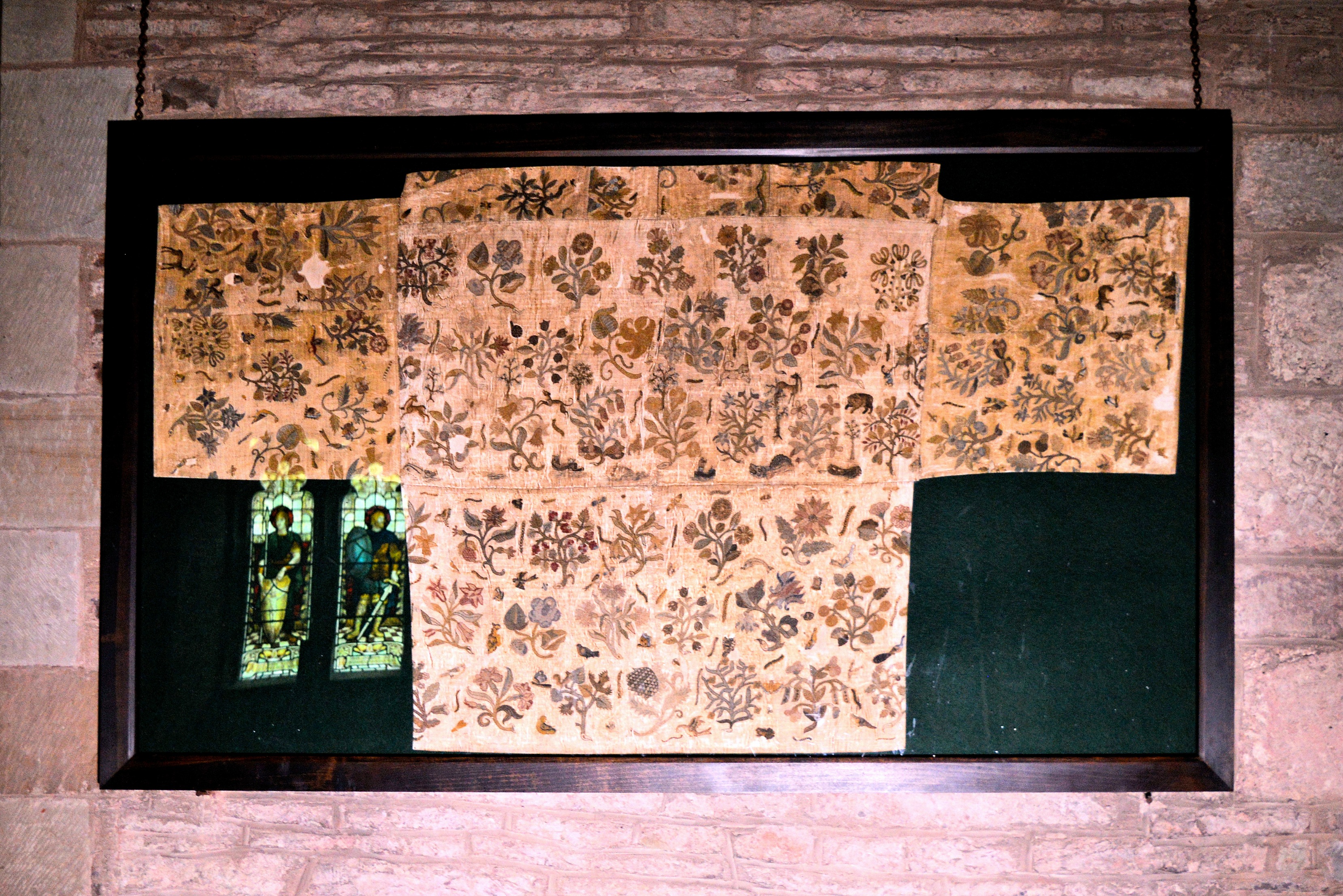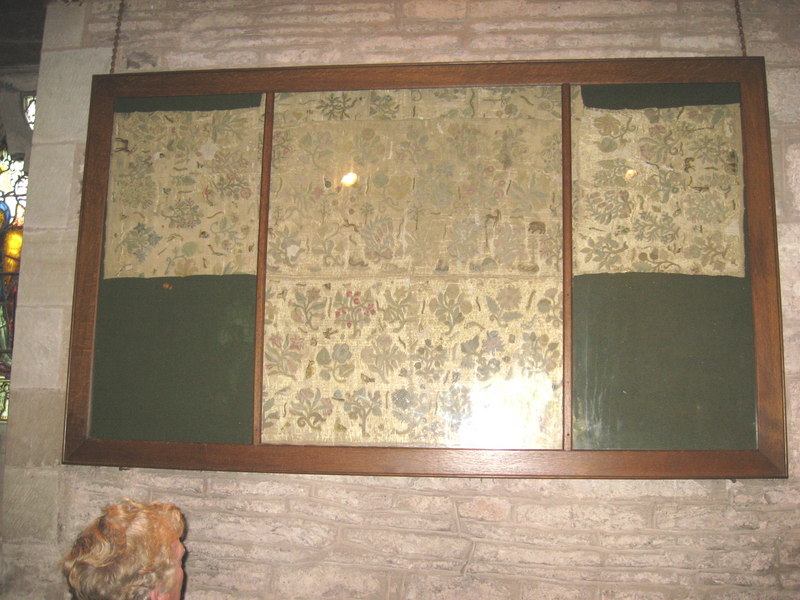Bacton Altar Cloth on:
[Wikipedia]
[Google]
[Amazon]
 The Bacton Altar Cloth is a 16th-century garment that is considered the sole surviving dress of Queen
The Bacton Altar Cloth is a 16th-century garment that is considered the sole surviving dress of Queen
 The garment is made of cream-coloured silk and Italian cloth of silver. Cloth of silver was, under
The garment is made of cream-coloured silk and Italian cloth of silver. Cloth of silver was, under

 The dress dates to late in Queen
The dress dates to late in Queen
See The Lost Dress of Elizabeth I
{{Elizabeth I Elizabeth I 16th-century fashion English fashion Royal dresses Material culture of royal courts Individual dresses
 The Bacton Altar Cloth is a 16th-century garment that is considered the sole surviving dress of Queen
The Bacton Altar Cloth is a 16th-century garment that is considered the sole surviving dress of Queen Elizabeth I
Elizabeth I (7 September 153324 March 1603) was Queen of England and Ireland from 17 November 1558 until her death in 1603. Elizabeth was the last of the five House of Tudor monarchs and is sometimes referred to as the "Virgin Queen".
El ...
. The cloth, embroidered in an elaborate floral design and made of cloth of silver, is an important relic of Tudor fashion
Fashion is a form of self-expression and autonomy at a particular period and place and in a specific context, of clothing, footwear, lifestyle, accessories, makeup, hairstyle, and body posture. The term implies a look defined by the fashion in ...
and luxury trade, containing dyes from as far away as India and Mexico. It was rediscovered in 2015 at St Faith's Church in Bacton, Herefordshire
Herefordshire () is a county in the West Midlands of England, governed by Herefordshire Council. It is bordered by Shropshire to the north, Worcestershire to the east, Gloucestershire to the south-east, and the Welsh counties of Monmouthshire ...
, where it had been used as an altar cloth
An altar cloth is used in the Christian liturgy to cover the altar. It serves as a sign of reverence as well as a decoration and a protection of the altar and the sacred vessels. In the orthodox churches is covered by the antimension, which also c ...
for centuries. After several years of conservation and restoration, the garment was exhibited to the public in 2019 and 2020 along with the '' Rainbow Portrait'', in which the queen is depicted wearing a highly similar dress.
Description
 The garment is made of cream-coloured silk and Italian cloth of silver. Cloth of silver was, under
The garment is made of cream-coloured silk and Italian cloth of silver. Cloth of silver was, under Sumptuary Law
Sumptuary laws (from Latin ''sūmptuāriae lēgēs'') are laws that try to regulate consumption. '' Black's Law Dictionary'' defines them as "Laws made for the purpose of restraining luxury or extravagance, particularly against inordinate expendi ...
, reserved for members of the royal family, which was an early clue of its origin. It was elaborately embroidered with colourful flowers and vegetation in silk, silver and gold thread, including caterpillars and deer. Unusually, the embroidery was stitched straight onto the fabric, indicating expert workmanship and therefore an elite owner. Dye used in the embroidery thread included cochineal
The cochineal ( , ; ''Dactylopius coccus'') is a scale insect in the suborder Sternorrhyncha, from which the natural dye carmine is derived. A primarily sessility (motility), sessile parasitism, parasite native to tropical and subtropical Sout ...
red from Mexico, evidence of early trade from North America, as well Indian indigo
Indigo is a deep color close to the color wheel blue (a primary color in the RGB color space), as well as to some variants of ultramarine, based on the ancient dye of the same name. The word "indigo" comes from the Latin word ''indicum'', m ...
blue traded through Portugal.
History of the dress

 The dress dates to late in Queen
The dress dates to late in Queen Elizabeth I
Elizabeth I (7 September 153324 March 1603) was Queen of England and Ireland from 17 November 1558 until her death in 1603. Elizabeth was the last of the five House of Tudor monarchs and is sometimes referred to as the "Virgin Queen".
El ...
's life, when she was nearly 70. It is highly similar to the embroidered dress she is depicted wearing in her '' Rainbow Portrait''. The style of the floral embroidery puts the dress squarely into the 1590s, as anything from later years would have featured more scroll-like detail on the stems and vines, in line with early Stuart trends; additionally, only inventories from the later part of Elizabeth's reign show such expensive dresses were in her possession.
It was believed the garment was given to Bacton by the Queen in memory of Blanche Parry
Blanche Parry (1507/8–12 February 1590) of Newcourt in the parish of Bacton, Herefordshire, in the Welsh Marches, was a personal attendant of Queen Elizabeth I, who held the offices of Chief Gentlewoman of the Queen's Most Honourable Privy C ...
. Parry, from Bacton, was a personal attendant of the Queen, and held the offices of Chief Gentlewoman of the Queen's Most Honourable Privy Chamber
A privy chamber was the private apartment of a royal residence in England.
The Gentlemen of the Privy Chamber were noble-born servants to the Crown who would wait and attend on the King in private, as well as during various court activities, f ...
and Keeper of Her Majesty's Jewels. Parry, who never married, remained devoted to Elizabeth and was her longest-serving courtier, by her side for 56 years.
The Altar Cloth had survived the centuries as it was considered a sacred object by the parishioners at St Faith's Church in Bacton, where in 1909, it was framed in oak and mounted on the wall above the pews. Nearby is the Blanche Parry Monument, the earliest depiction of the Queen as Gloriana
''Gloriana'', Op. 53, is an opera in three acts by Benjamin Britten to an English libretto by William Plomer, based on Lytton Strachey's 1928 ''Elizabeth and Essex: A Tragic History''.
The first performance was presented at the Royal Opera Hous ...
. For 106 years the framed cloth remained on the north wall, away from direct sunlight, which helped preserve the garment from fading.
Return to prominence
In the early 20th century, SirLionel Cust
Sir Lionel Henry Cust (25 January 1859 – 12 October 1929) was a British art historian, courtier and museum director. He was director of the National Portrait Gallery from 1895 to 1909 and co-edited ''The Burlington Magazine'' from 1909 to 191 ...
, then Surveyor of the King's Pictures
The office of the Surveyor of the King's/Queen's Pictures, in the Royal Collection Department of the Royal Household of the Sovereign of the United Kingdom, is responsible for the care and maintenance of the royal collection of pictures owned ...
, recognised the importance of the cloth and published an article in 1918 about its similarity to the costume of Elizabeth I depicted in her portraits.Lionel Henry Cust, 'Queen Elizabeth's Kirtle', ''The Burlington Magazine'', 33:189 (December 1918), pp. 196–201.
In 2015, the garment was researched by Ruth Elizabeth Richardson while writing a biography of Blanche Parry
Blanche Parry (1507/8–12 February 1590) of Newcourt in the parish of Bacton, Herefordshire, in the Welsh Marches, was a personal attendant of Queen Elizabeth I, who held the offices of Chief Gentlewoman of the Queen's Most Honourable Privy C ...
and Lady Troy
Blanche Milborne, Lady Herbert of Troy was the Lady Mistress in charge of the upbringing of Queen Elizabeth I, Edward VI and also of Queen Mary when she lived with the younger Tudor children. She was twice married, and widowed; first to James ...
. Richardson recognised the rarity and importance of the cloth.
Subsequently, Eleri Lynn, a curator at the Historic Royal Palaces
Historic Royal Palaces is an independent charity that manages some of the United Kingdom's unoccupied royal palaces.
These are:
* Tower of London
* Hampton Court Palace
* Kensington Palace (State Apartments and Orangery)
* The Banqueting Hous ...
who was researching a book on Tudor fashion, saw Richardson's photos of the cloth online. Lynn examined the cloth and discovered it was of extraordinarily high quality, while also observing evidence of pattern cutting that ultimately revealed it had been a dress. Lynn recognised that it is a unique survival, being the only known cloth with direct embroidery from any museum or collection worldwide. This led to the cloth being restored and eventually displayed to the public at Hampton Court Palace
Hampton Court Palace is a Grade I listed royal palace in the London Borough of Richmond upon Thames, southwest and upstream of central London on the River Thames. The building of the palace began in 1514 for Cardinal Thomas Wolsey, the chie ...
.
See also
*List of individual dresses
This is a list of individual dresses which are famous or otherwise notable.
Dresses worn by celebrities
* American Express Gold card dress of Lizzy Gardiner
* Black Christian Siriano gown of Billy Porter
* Black dress of Rita Hayworth
* Black G ...
References
Further reading
* Richardson, Ruth Elizabeth, ''Mistress Blanche Queen Elizabeth I's Confidante'', (first edition 2007) second edition 2018, Logaston Press, Eardisley, Herefordshire. * Richardson, Ruth Elizabeth, "Elizabeth I's Earliest Influences: New Discoveries Concerning Blanche Parry, Lady Troy, the Funeral Monuments and the Bacton Altar Cloth", ''The Court Historian'', May 2020. * Lynn, Eleri, 'The Bacton Altar Cloth: Elizabeth I's 'long-lost skirt'?', ''Costume'', 52:1 (March 2018), pp. 3-25. * Lynn, Eleri, ''Tudor Fashion'', 2017, Yale University Press, New Haven and London, in association with Historic Royal Palaces. * Arnold, Janet, ''Queen Elizabeth's Wardrobe Unlock'd'', 2014, Maney.External links
*Hampton Court Palace
Hampton Court Palace is a Grade I listed royal palace in the London Borough of Richmond upon Thames, southwest and upstream of central London on the River Thames. The building of the palace began in 1514 for Cardinal Thomas Wolsey, the chie ...
See The Lost Dress of Elizabeth I
{{Elizabeth I Elizabeth I 16th-century fashion English fashion Royal dresses Material culture of royal courts Individual dresses